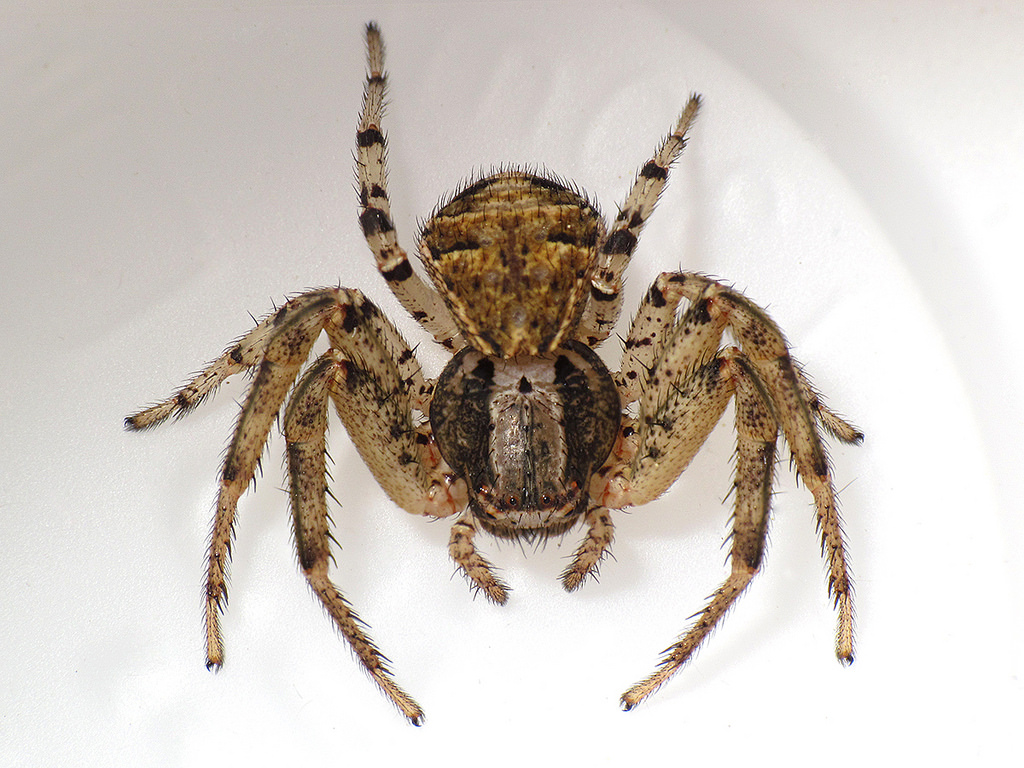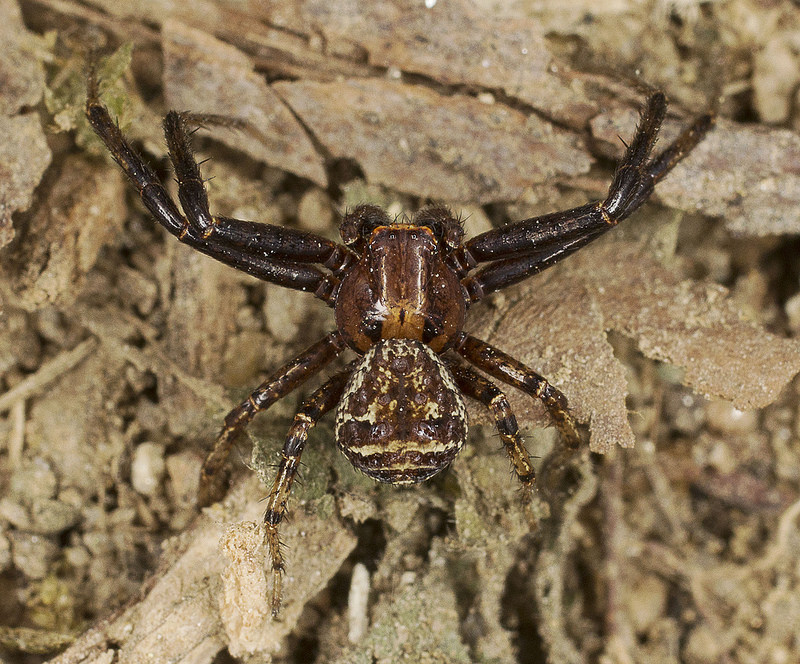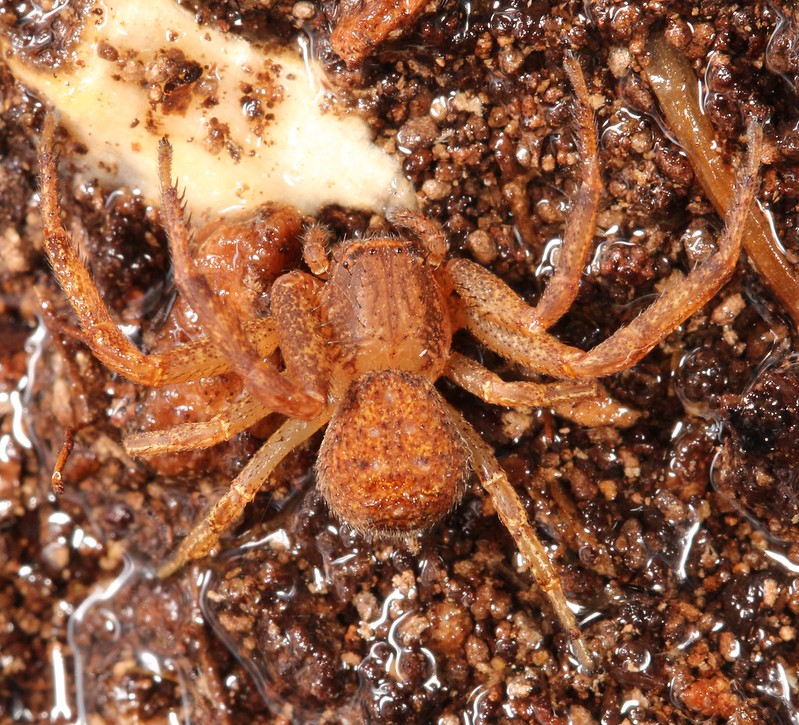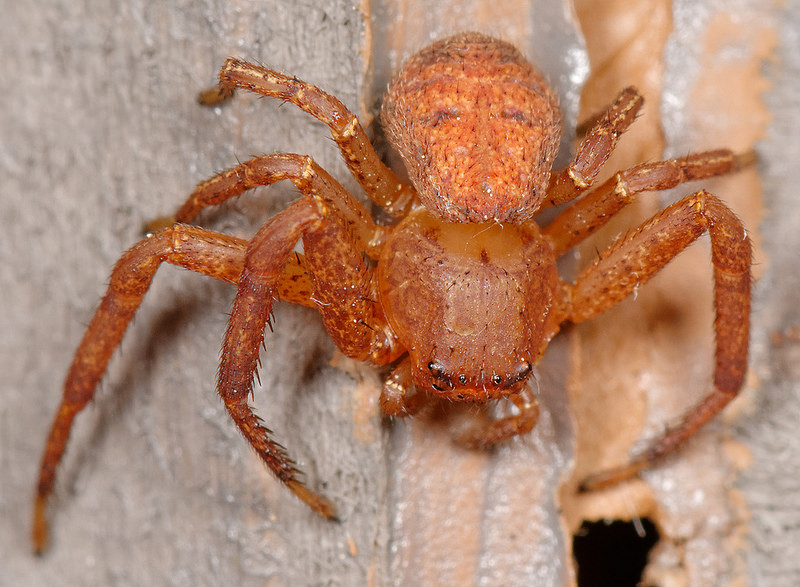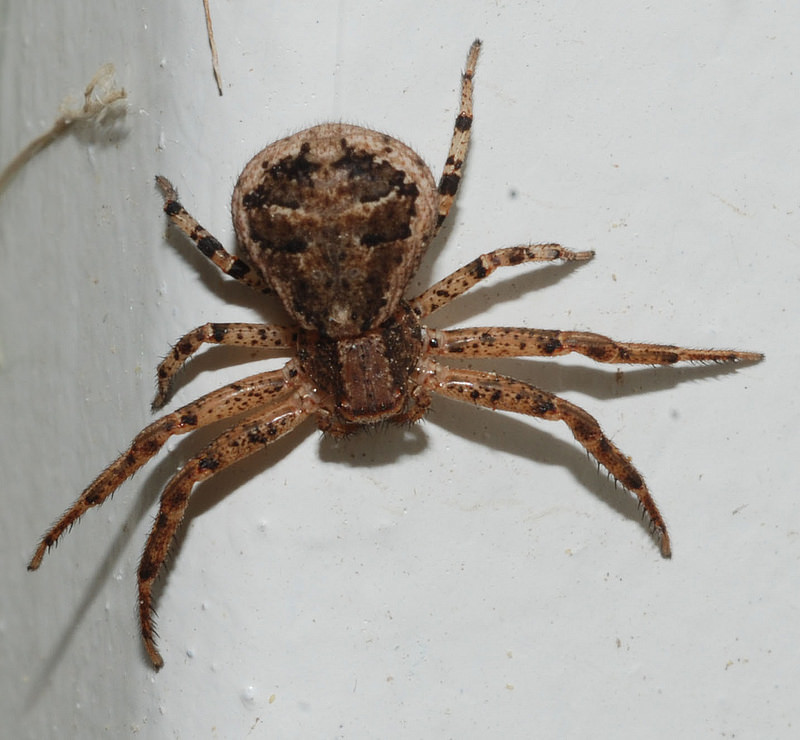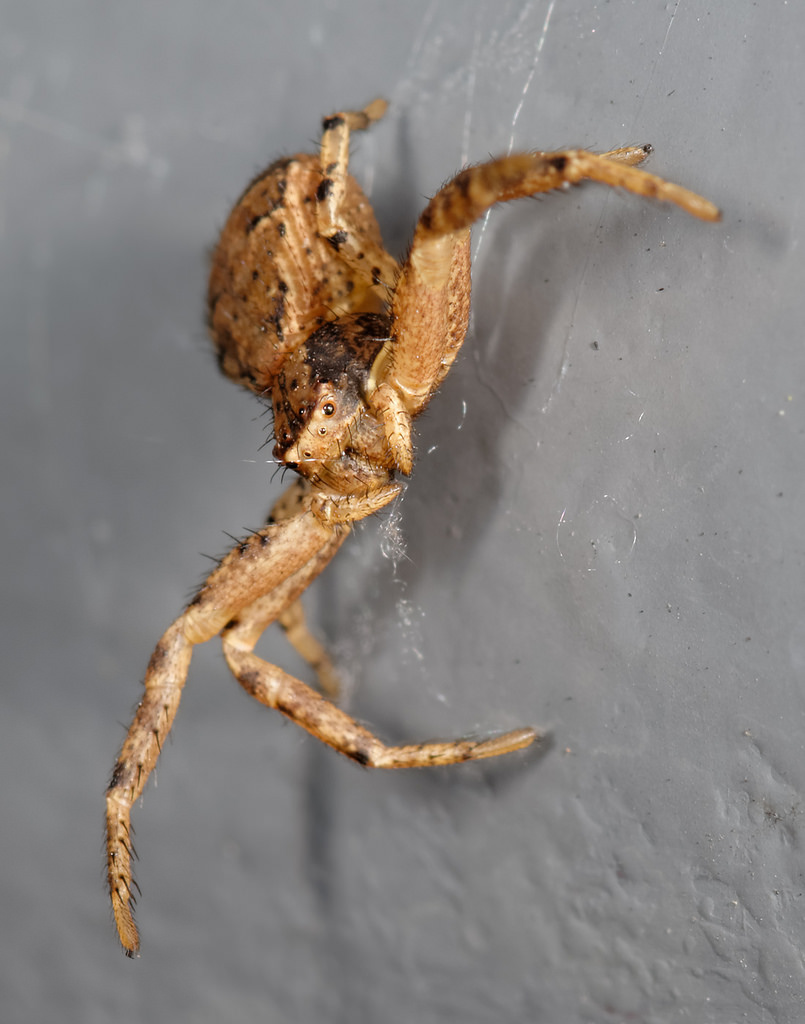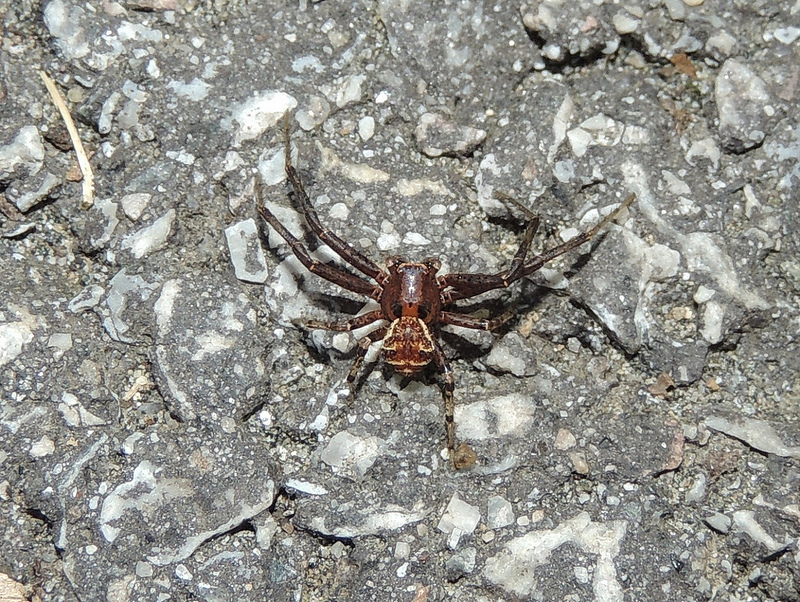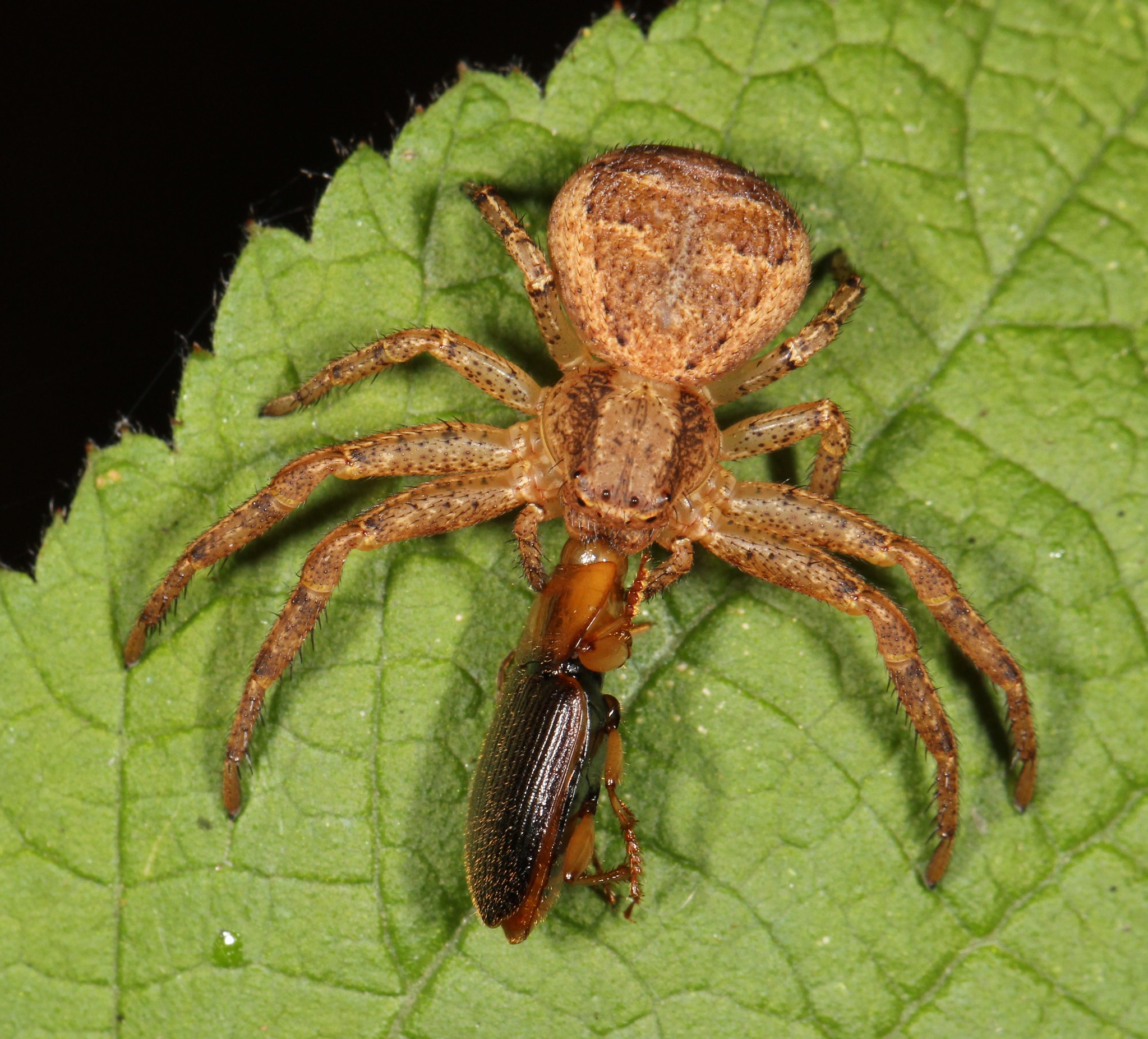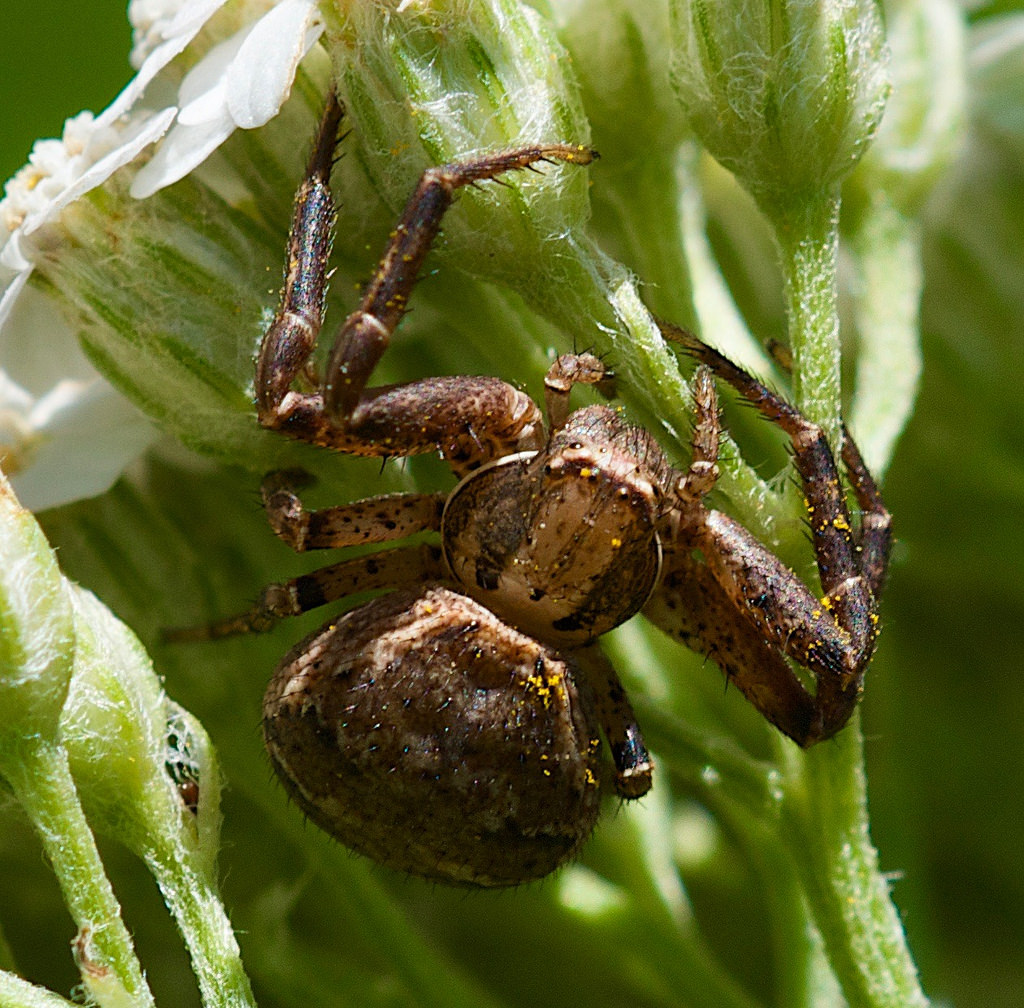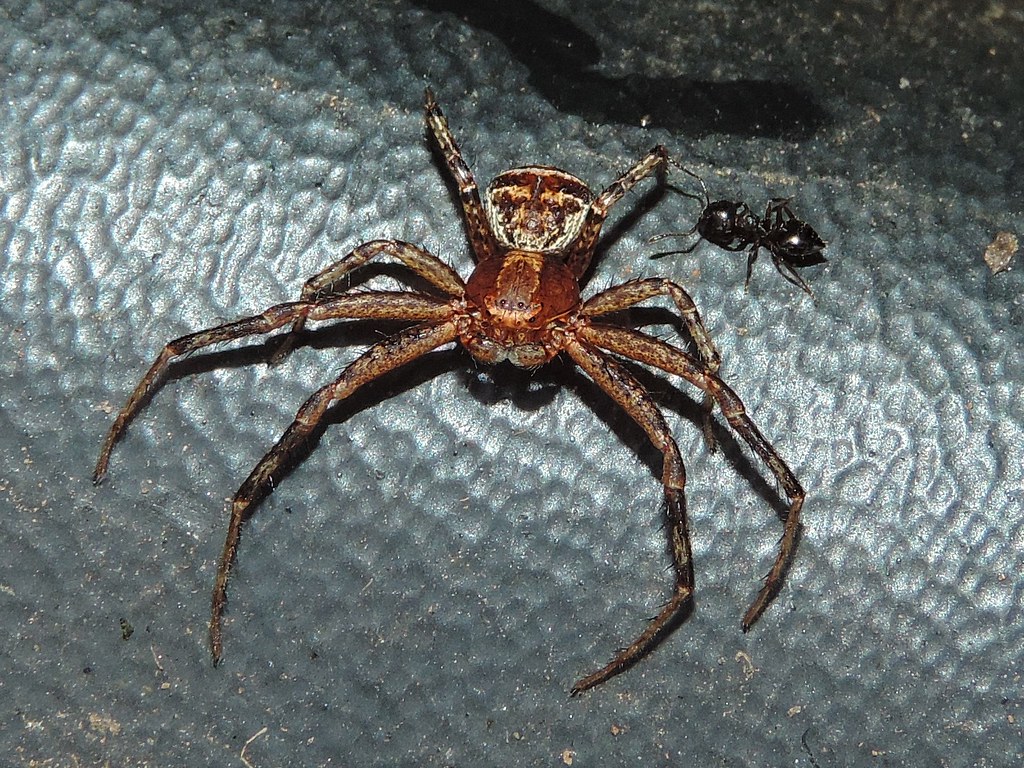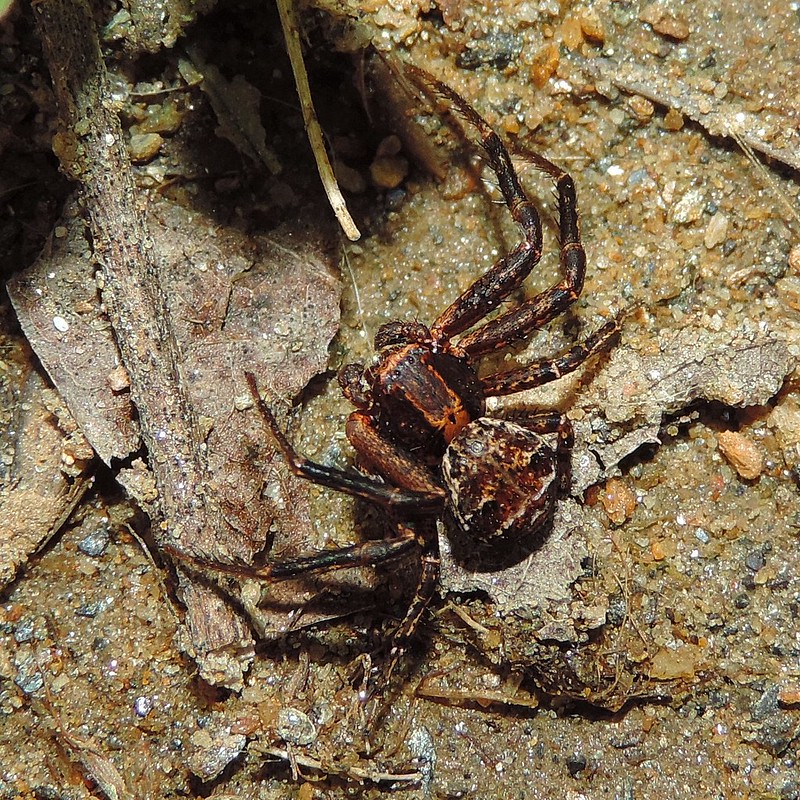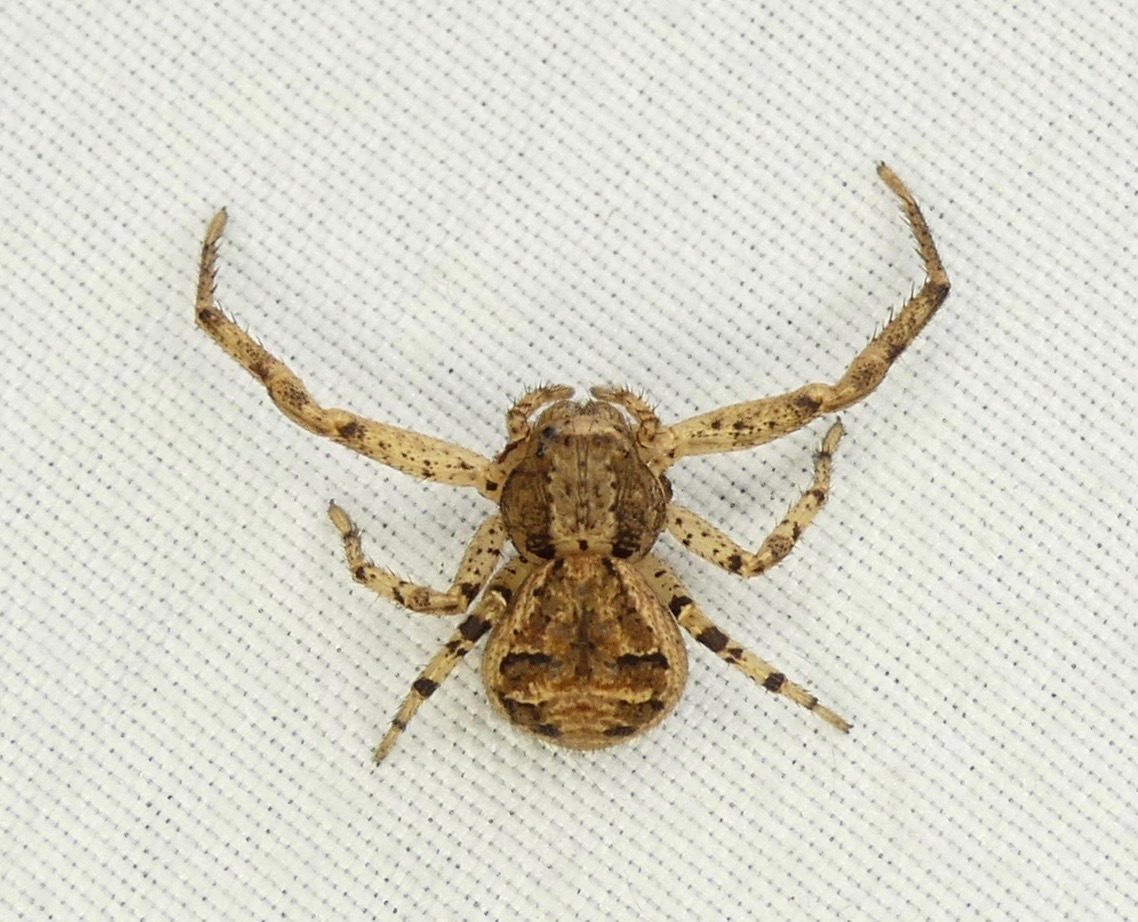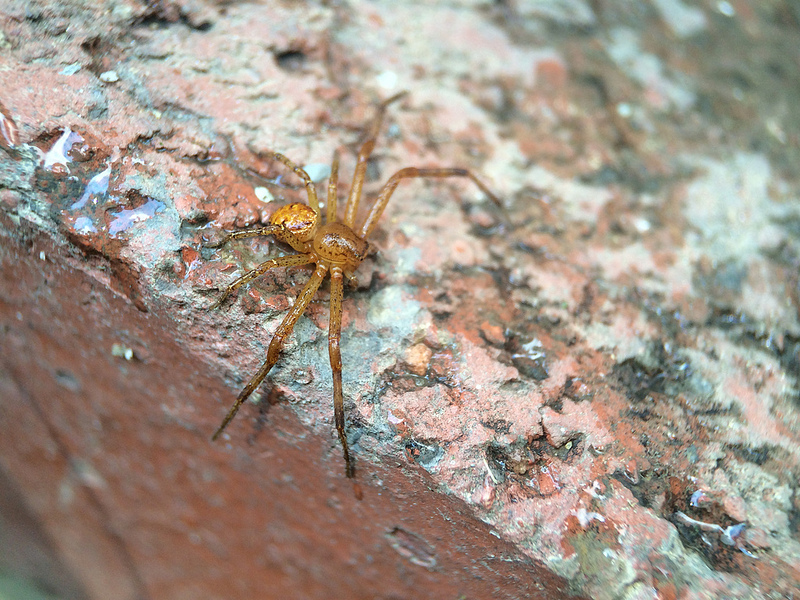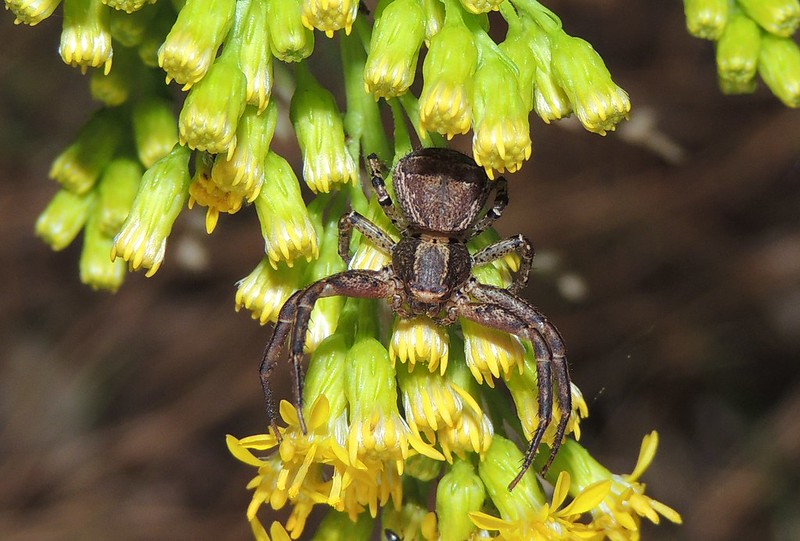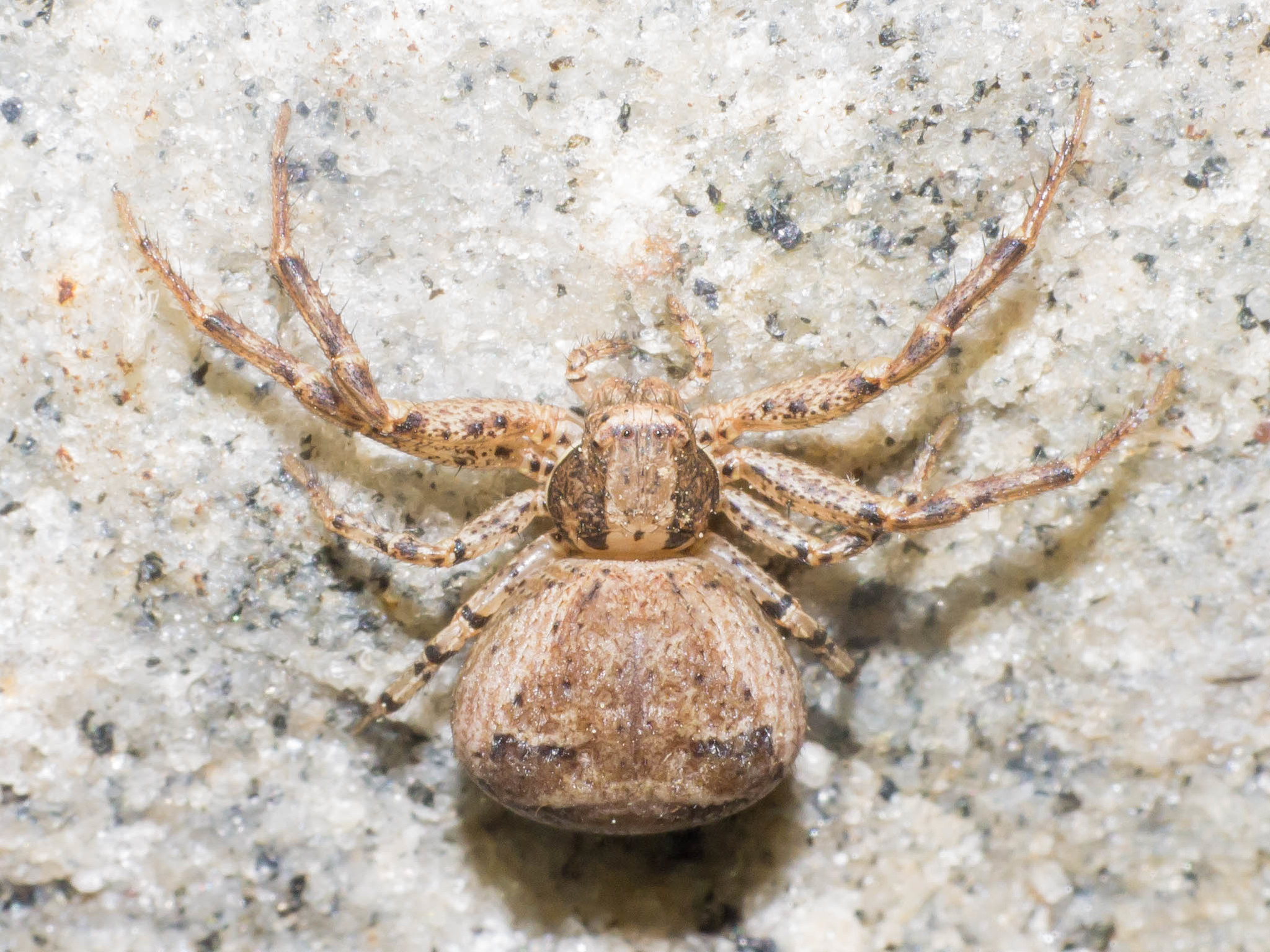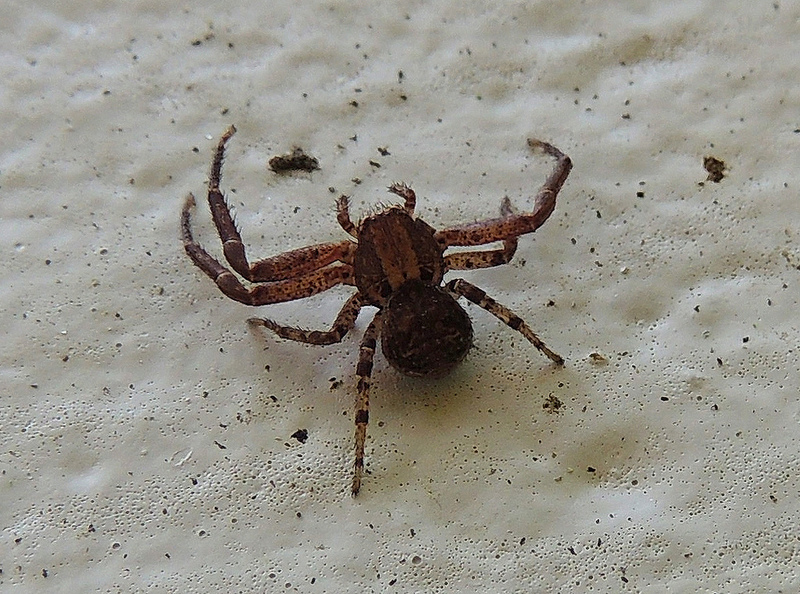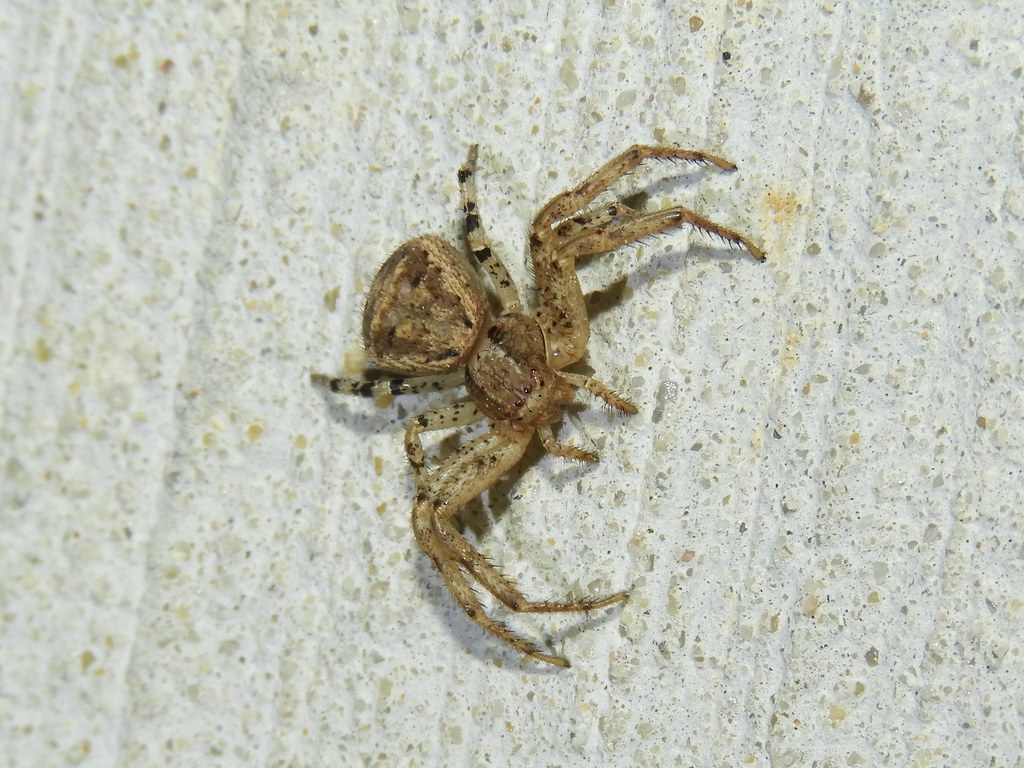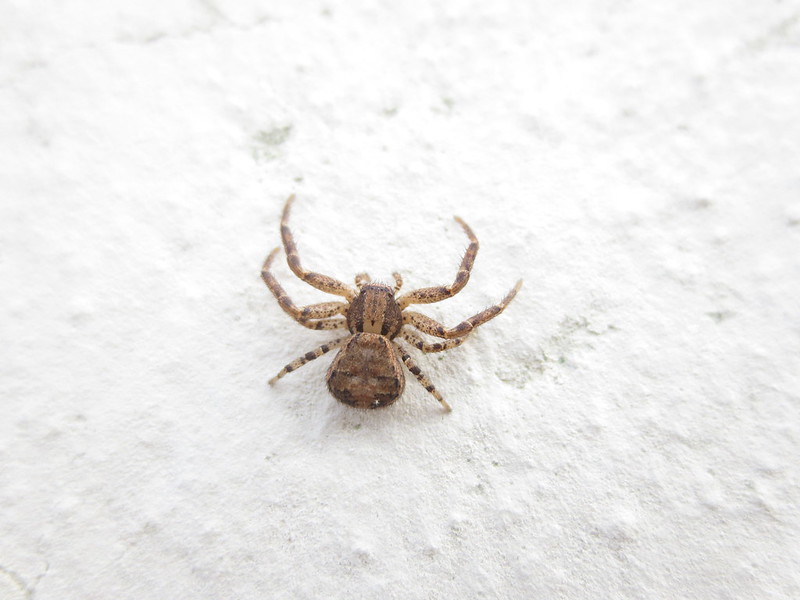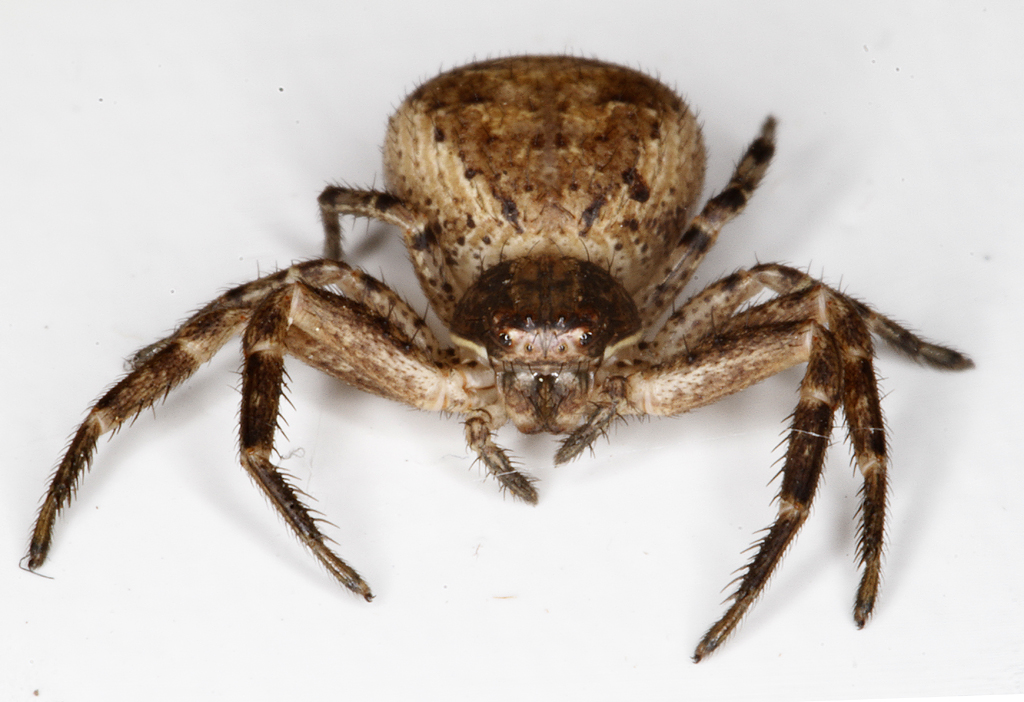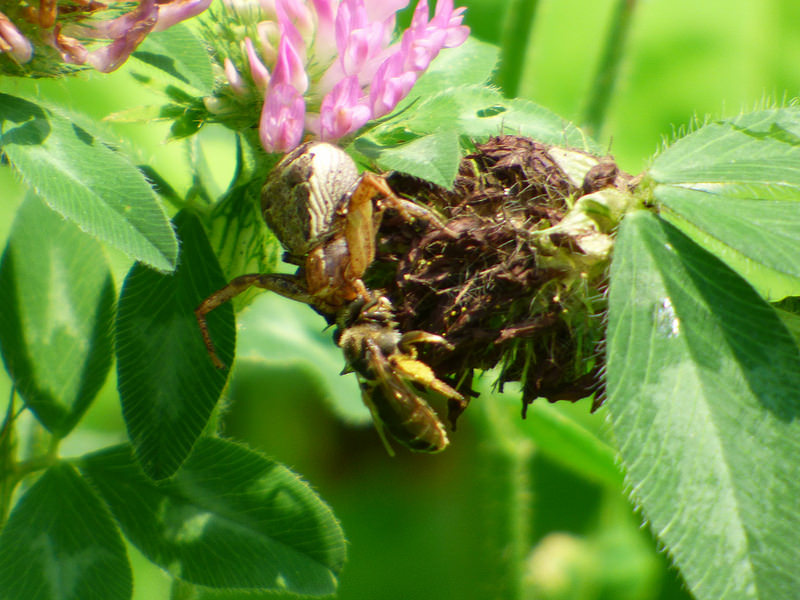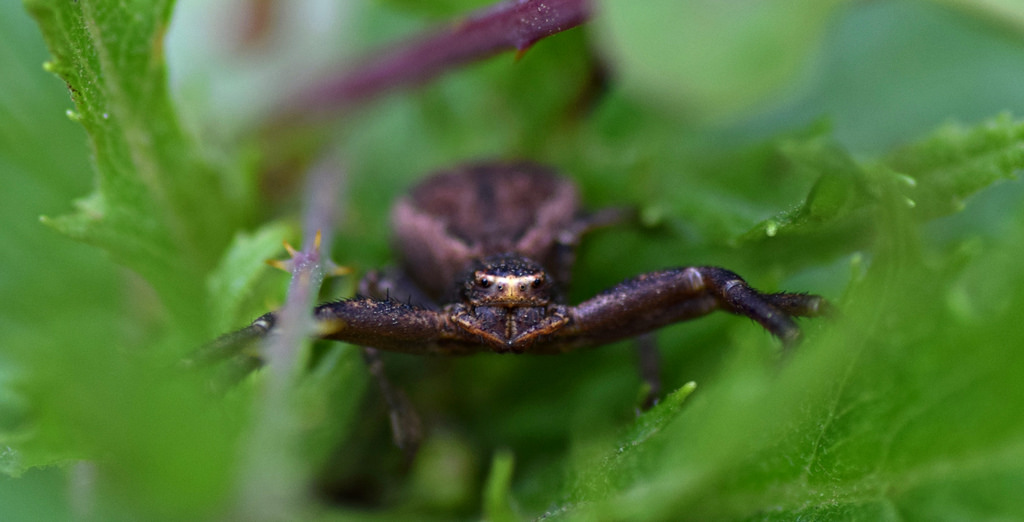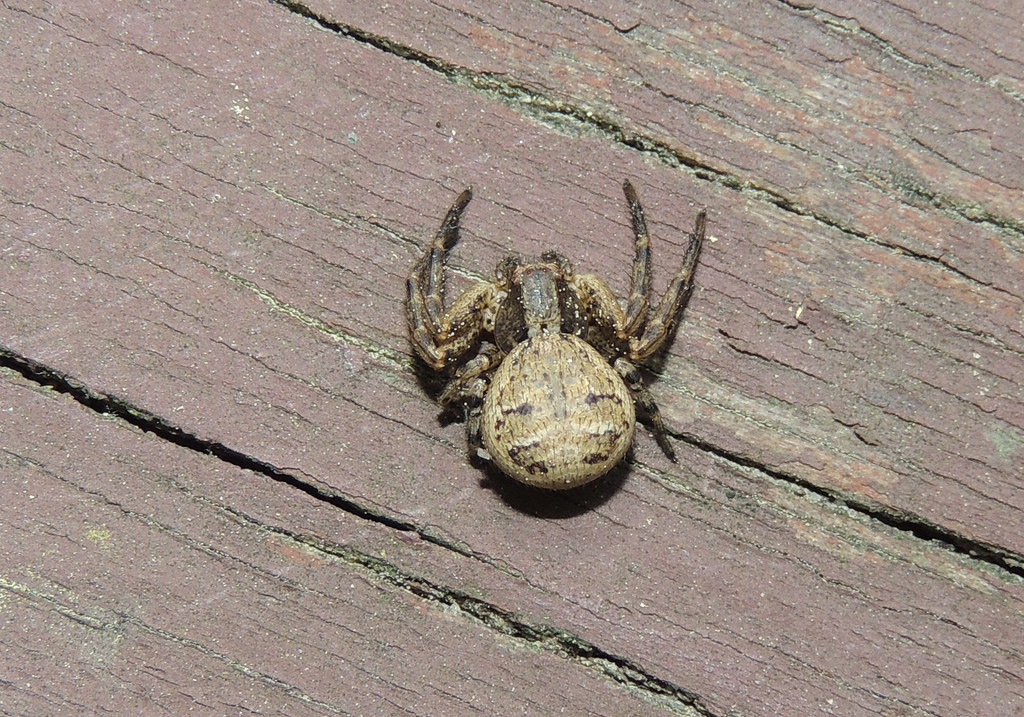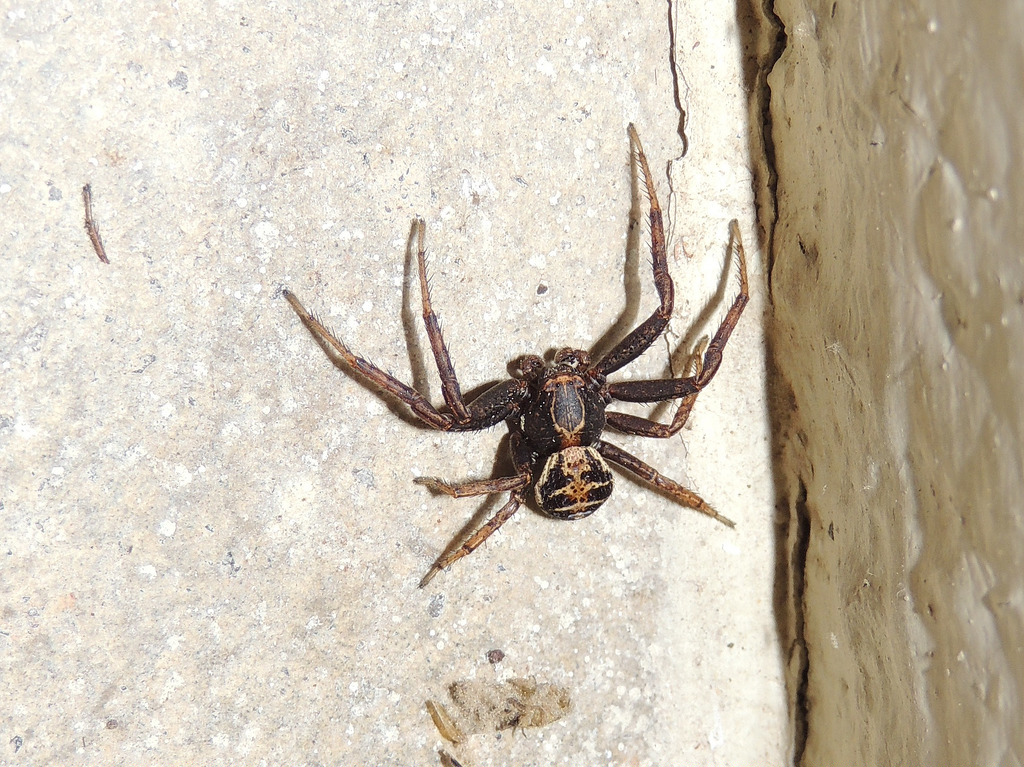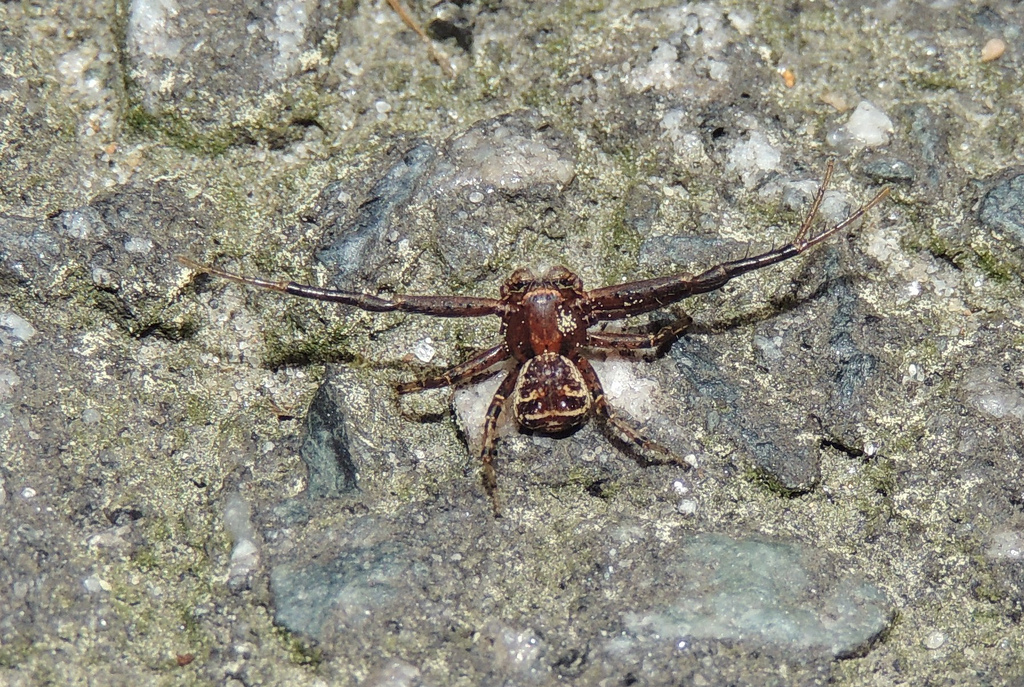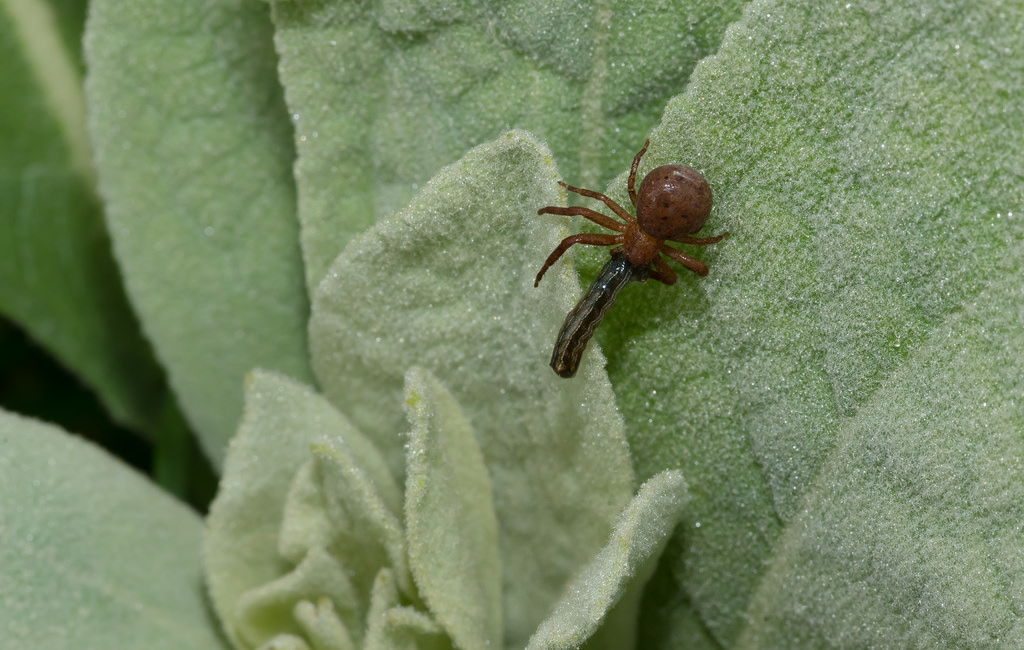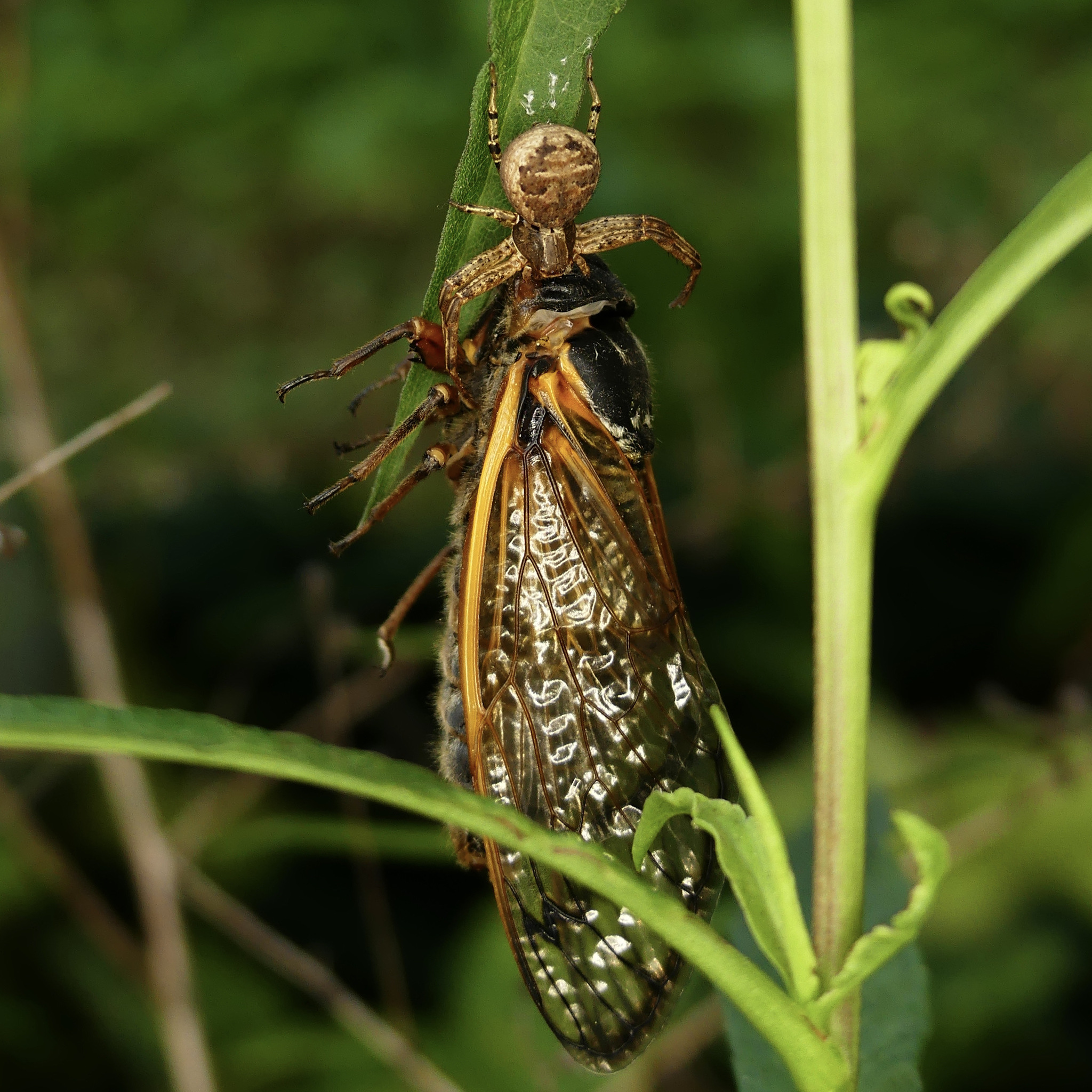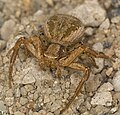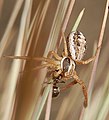Map Snapshot




















77 Records
Status
This genus may not yet be understood well enough to permit identification from photos (Joe Lapp, pers. comm.).
Seasonality Snapshot
Source: Wikipedia
| Ground crab spiders Temporal range:
| |
|---|---|

| |
| Xysticus sp. | |
| Scientific classification | |
| Domain: | Eukaryota |
| Kingdom: | Animalia |
| Phylum: | Arthropoda |
| Subphylum: | Chelicerata |
| Class: | Arachnida |
| Order: | Araneae |
| Infraorder: | Araneomorphae |
| Family: | Thomisidae |
| Genus: | Xysticus C. L. Koch, 1835 |
| Species | |
|
See text | |

Xysticus is a genus of ground crab spiders described by C. L. Koch in 1835, belonging to the order Araneae, family Thomisidae. The genus name is derived from the Ancient Greek root xyst, meaning "scraped, scraper".
Description
[edit]Xysticus and Coriarachne are dark brown or reddish-brown crab spiders often encountered on weeds or trees. While similar to the 'flower spiders', they tend to have shorter, sturdier legs. Many, but not all, species have abdomens more patterned than most Thomisus species, rather like some of the Synema species. Some however, that are more terrestrial, resemble earth in colour and texture.

Most species of the genus Xysticus are small to medium sized spiders. They show a sexual dimorphism in size. Females of typical species reach a maximum of 10 millimetres (0.39 in) of body length, while their males are about 3–5 millimetres (0.12–0.20 in) long, about half the size of the females.
The basic colour of these species is usually brown, beige or gray. The prosoma is sometimes slightly smaller than the opisthosoma. In many species the front body shows in the middle a broad, pale longitudinal band. The opisthosoma is clearly flattened in most species and shows a median broad and dark leaf marking.
The species are often very similar to each other, and in most cases can be distinguished only by a microscopic examination of the reproductive organs.
Behaviour
[edit]The spiders of the genus Xysticus do not build webs; like most Thomisidae they are ambush hunters and prefer to hunt near the ground (hence the common name "ground crab spiders"). They move slowly, and commonly hunt by stationing themselves in a high-traffic area and grabbing whatever arthropod passes close enough. Also like most other Thomisidae, they seize prey with their enlarged anterior two pairs of legs and kill it by a venomous bite.
Species
[edit]As of December 2022[update] it contains 293 species, found worldwide:[1]
- Xysticus abditus Logunov, 2006 — Bulgaria, Turkey
- Xysticus acerbus Thorell, 1872 — Europe to Central Asia
- Xysticus acerbus obscurior Kulczyński, 1895 — Ukraine
- Xysticus acquiescens Emerton, 1919 — Holarctic
- Xysticus advectus O. P.-Cambridge, 1890 — Guatemala, Costa Rica
- Xysticus aethiopicus L. Koch, 1875 — Ethiopia
- Xysticus albertensis Dondale, 2008 — Canada
- Xysticus albolimbatus Hu, 2001 — China
- Xysticus alboniger Turnbull, Dondale & Redner, 1965 — USA, Canada
- Xysticus aletaiensis Hu & Wu, 1989 — China
- Xysticus alpicola Kulczyński, 1882 — Czech Republic, Slovakia, Poland, Ukraine
- Xysticus alpinistus Ono, 1978 — Nepal, China
- Xysticus alpinus Kulczyński, 1887 — Alps (Switzerland, Italy, Germany, Austria)
- Xysticus alsus Song & Wang, 1994 — China
- Xysticus altaicus Simon, 1895 — Kazakhstan
- Xysticus altitudinis Levy, 1976 — Israel
- Xysticus ampullatus Turnbull, Dondale & Redner, 1965 — USA, Canada
- Xysticus apachecus Gertsch, 1933 — USA
- Xysticus apalacheus Gertsch, 1953 — USA
- Xysticus apertus Banks, 1898 — Mexico
- Xysticus apricus L. Koch, 1876 — Italy
- Xysticus aprilinus Bryant, 1930 — USA
- Xysticus arenarius Thorell, 1875 — Ukraine
- Xysticus arenicola Simon, 1875 — France
- Xysticus argenteus Jézéquel, 1966 — Ivory Coast
- Xysticus asper (Lucas, 1838) — Canary Islands
- Xysticus atevs Ovtsharenko, 1979 — Russia
- Xysticus atrimaculatus Bösenberg & Strand, 1906 — China, Korea, Japan
- Xysticus auctificus Keyserling, 1880 — USA, Canada
- Xysticus audax (Schrank, 1803) — Palearctic
- Xysticus audax massanicus Simon, 1932 — France
- Xysticus audaxoides Zhang, Zhang & Song, 2004 — China
- Xysticus austrosibiricus Logunov & Marusik, 1998 — Russia, Mongolia, China
- Xysticus autumnalis L. Koch, 1875 — New South Wales
- Xysticus aztecus Gertsch, 1953 — Mexico
- Xysticus bacurianensis Mcheidze, 1971 — Turkey, Russia, Georgia, Azerbaijan
- Xysticus bakanas Marusik & Logunov, 1990 — Kazakhstan
- Xysticus banksi Bryant, 1933 — USA
- Xysticus barbatus Caporiacco, 1936 — Libya
- Xysticus benefactor Keyserling, 1880 — USA, Canada
- Xysticus bengalensis Tikader & Biswas, 1974 — India
- Xysticus bengdakus Saha & Raychaudhuri, 2007 — India
- Xysticus beni Strand, 1913 — Central Africa
- Xysticus berlandi Schenkel, 1963 — China
- Xysticus bermani Marusik, 1994 — Russia, China
- Xysticus bharatae Gajbe & Gajbe, 1999 — India
- Xysticus bicolor L. Koch, 1867 — Greece
- Xysticus bicuspis Keyserling, 1887 — USA
- Xysticus bifasciatus C. L. Koch, 1837 — Palearctic
- Xysticus bimaculatus L. Koch, 1867 — Queensland
- Xysticus bohdanowiczi Zhang, Zhu & Song, 2004 — China
- Xysticus bolivari Gertsch, 1953 — Mexico
- Xysticus bradti Gertsch, 1953 — Mexico
- Xysticus breviceps O. P.-Cambridge, 1885 — India
- Xysticus brevidentatus Wunderlich, 1995 — Italy, Croatia, Bosnia and Herzegoniva, Montenegro, Albania
- Xysticus britcheri Gertsch, 1934 — Russia, Alaska, Canada, USA
- Xysticus brunneitibiis Caporiacco, 1939 — Ethiopia
- Xysticus californicus Keyserling, 1880 — USA, Mexico
- Xysticus canadensis Gertsch, 1934 — Russia, USA, Canada
- Xysticus caspicus Utochkin, 1968 — Russia, Turkmenistan, Kazakhstan
- Xysticus caucasius L. Koch, 1878 — Georgia
- Xysticus chaparralis Schick, 1965 — USA
- Xysticus charitonowi Mcheidze, 1971 — Georgia
- Xysticus chippewa Gertsch, 1953 — Holarctic
- Xysticus chui Ono, 1992 — Taiwan
- Xysticus clercki (Audouin, 1826) — Egypt, Ethiopia
- Xysticus cochise Gertsch, 1953 — USA
- Xysticus coloradensis Bryant, 1930 — USA
- Xysticus concinnus Kroneberg, 1875 — Central Asia
- Xysticus concretus Utochkin, 1968 — Russia, China, Korea, Japan
- Xysticus concursus Gertsch, 1934 — USA
- Xysticus conflatus Song, Tang & Zhu, 1995 — China
- Xysticus connectens Kulczyński, 1901 — China
- Xysticus cor Canestrini, 1873 — Southern Europe, Turkey, Azores, Iran
- Xysticus corsicus Simon, 1875 — Corsica
- Xysticus crispabilis Song & Gao, 1996 — China
- Xysticus cristatus (Clerck, 1757) — Palearctic, Introduced to Canada, USA
- Xysticus croceus Fox, 1937 — India, Nepal, Bhutan, China, Vietnam, Korea, Taiwan, Japan
- Xysticus cunctator Thorell, 1877 — USA, Canada
- Xysticus curtus Banks, 1898 — Mexico
- Xysticus dali Li & Yang, 2008 — China
- Xysticus davidi Schenkel, 1963 — Russia, China
- Xysticus denisi Schenkel, 1963 — China
- Xysticus desidiosus Simon, 1875 — Europe
- Xysticus discursans Keyserling, 1880 — North America
- Xysticus diversus (Blackwall, 1870) — Sicily
- Xysticus doriai (Dalmas, 1922) — Italy
- Xysticus dzhungaricus Tyschchenko, 1965 — Russia, Central Asia to China
- Xysticus edax (O. P.-Cambridge, 1872) — Turkey, Israel
- Xysticus elegans Keyserling, 1880 — USA, Canada, Alaska
- Xysticus elephantus Ono, 1978 — Nepal, China
- Xysticus ellipticus Turnbull, Dondale & Redner, 1965 — USA, Canada
- Xysticus emertoni Keyserling, 1880 — USA, Canada, Alaska, Slovakia to China
- Xysticus ephippiatus Simon, 1880 — Kazakhstan, Russia, Central Asia, Mongolia, China, Korea, Japan
- Xysticus erraticus (Blackwall, 1834) — Europe, Russia
- Xysticus facetus O. P.-Cambridge, 1896 — Mexico to El Salvador
- Xysticus fagei Lessert, 1919 — East Africa
- Xysticus federalis Gertsch, 1953 — Mexico
- Xysticus ferox (Hentz, 1847) — USA, Canada
- Xysticus ferrugineus Menge, 1876 — Palearctic
- Xysticus ferruginoides Schenkel, 1963 — Russia, Mongolia
- Xysticus fervidus Gertsch, 1953 — USA, Canada
- Xysticus flavitarsis Simon, 1877 — Congo
- Xysticus flavovittatus Keyserling, 1880 — USA
- Xysticus floridanus Banks, 1896 — USA
- Xysticus fraternus Banks, 1895 — USA, Canada
- Xysticus funestus Keyserling, 1880 — North America
- Xysticus furtivus Gertsch, 1936 — USA
- Xysticus gallicus Simon, 1875 — Palearctic
- Xysticus gallicus batumiensis Mcheidze & Utochkin, 1971 — Georgia
- Xysticus gattefossei Denis, 1956 — Morocco
- Xysticus geometres L. Koch, 1874 — Queensland
- Xysticus gertschi Schick, 1965 — North America
- Xysticus ghigii Caporiacco, 1938 — Mexico
- Xysticus gortanii Caporiacco, 1922 — Italy
- Xysticus gosiutus Gertsch, 1933 — USA, Canada
- Xysticus gracilis Keyserling, 1880 — Colombia
- Xysticus grallator Simon, 1932 — Portugal, Spain, France (Corsica), Italy (Sardinia)
- Xysticus guizhou Song & Zhu, 1997 — China
- Xysticus gulosus Keyserling, 1880 — North America
- Xysticus havilandi Lawrence, 1942 — South Africa
- Xysticus hedini Schenkel, 1936 — Russia, Mongolia, China, Korea, Japan
- Xysticus helophilus Simon, 1890 — Yemen
- Xysticus hepaticus Simon, 1903 — Madagascar
- Xysticus himalayaensis Tikader & Biswas, 1974 — India
- Xysticus hindusthanicus Basu, 1965 — India
- Xysticus hui Platnick, 1993 — China
- Xysticus humilis Redner & Dondale, 1965 — USA
- Xysticus ibex Simon, 1875 — France, Spain
- Xysticus ibex dalmasi Simon, 1932 — France
- Xysticus ictericus L. Koch, 1874 — Fiji
- Xysticus idolothytus Logunov, 1995 — Kazakhstan, Mongolia
- Xysticus illaudatus Logunov, 1995 — Russia
- Xysticus imitarius Gertsch, 1953 — USA
- Xysticus indiligens (Walckenaer, 1837) — USA
- Xysticus insulicola Bösenberg & Strand, 1906 — China, Korea, Japan
- Xysticus iviei Schick, 1965 — USA
- Xysticus iviei sierrensis Schick, 1965 — USA
- Xysticus jabalpurensis Gajbe & Gajbe, 1999 — India
- Xysticus jaharai Basu, 1979 — India
- Xysticus japenus Roewer, 1938 — Indonesia
- Xysticus jiangi Peng, Yin & Kim, 2000 — China
- Xysticus jinlin Song & Zhu, 1995 — China
- Xysticus joyantius Tikader, 1966 — India
- Xysticus jugalis L. Koch, 1875 — Ethiopia
- Xysticus jugalis larvatus Caporiacco, 1949 — Kenya
- Xysticus kalandadzei Mcheidze & Utochkin, 1971 — Georgia
- Xysticus kali Tikader & Biswas, 1974 — India
- Xysticus kamakhyai Tikader, 1962 — India
- Xysticus kansuensis Tang, Song & Zhu, 1995 — China, Japan
- Xysticus kashidi Tikader, 1963 — India
- Xysticus kaznakovi Utochkin, 1968 — Greece to Central Asia
- Xysticus kempeleni Thorell, 1872 — Europe to Central Asia
- Xysticus kempeleni nigriceps Simon, 1932 — France
- Xysticus khasiensis Tikader, 1980 — India
- Xysticus kochi Thorell, 1872 — Europe, Mediterranean to Central Asia
- Xysticus kochi abchasicus Mcheidze & Utochkin, 1971 — Georgia
- Xysticus kulczynskii Wierzbicki, 1902 — Azerbaijan, Iran
- Xysticus kurilensis Strand, 1907 — Russia, China, Korea, Japan
- Xysticus kuzgi Marusik & Logunov, 1990 — Central Asia
- Xysticus laetus Thorell, 1875 — Italy to Central Asia
- Xysticus lanio C. L. Koch, 1835 — Palearctic
- Xysticus lanio alpinus Kulczyński, 1887 — Austria
- Xysticus lapidarius Utochkin, 1968 — Central Asia
- Xysticus lassanus Chamberlin, 1925 — USA, Mexico
- Xysticus latitabundus Logunov, 1995 — Russia
- Xysticus lendli Kulczyński, 1897 — Hungary
- Xysticus lepnevae Utochkin, 1968 — Russia, Korea, Sakhalin
- Xysticus lineatus (Westring, 1851) — Palearctic
- Xysticus locuples Keyserling, 1880 — North America
- Xysticus logunovi Seyfulina & Mikhailov, 2004 — Russia
- Xysticus logunovorum Blick & Ono, 2021 — Iran
- Xysticus lucifugus Lawrence, 1937 — South Africa
- Xysticus luctans (C. L. Koch, 1845) — USA, Canada
- Xysticus luctator L. Koch, 1870 — Palearctic
- Xysticus luctuosus (Blackwall, 1836) — Holarctic
- Xysticus lutzi Gertsch, 1935 — USA, Mexico
- Xysticus macedonicus Silhavy, 1944 — Germany, Switzerland, Austria, Italy, Albania, North Macedonia, Greece, Turkey
- Xysticus maculatipes Roewer, 1962 — Afghanistan
- Xysticus maculiger Roewer, 1951 — Yarkand
- Xysticus manas Song & Zhu, 1995 — China
- Xysticus marmoratus Thorell, 1875 — Hungary, Slovakia, Bulgaria, Russia, Ukraine
- Xysticus martensi Ono, 1978 — Nepal
- Xysticus marusiki Ono & Martens, 2005 — Turkey, Iran
- Xysticus metinaktasi Demir, Seyyar & Türker, 2017 — Turkey
- Xysticus montanensis Keyserling, 1887 — USA, Canada, Alaska
- Xysticus mugur Marusik, 1990 — Russia
- Xysticus mulleri Lawrence, 1952 — South Africa
- Xysticus multiaculeatus Caporiacco, 1940 — Ethiopia
- Xysticus mundulus O. P.-Cambridge, 1885 — Yarkand
- Xysticus namaquensis Simon, 1910 — South Africa
- Xysticus natalensis Lawrence, 1938 — South Africa
- Xysticus nataliae Utochkin, 1968 — Russia
- Xysticus nigriceps Berland, 1922 — East Africa
- Xysticus nigropunctatus L. Koch, 1867 — Queensland
- Xysticus nigrotrivittatus (Simon, 1870) — Portugal, Spain
- Xysticus nitidus Hu, 2001 — China
- Xysticus nubilus Simon, 1875 — Macaronesia, Mediterranean, Georgia
- Xysticus nyingchiensis Song & Zhu, 1995 — China
- Xysticus obscurus Collett, 1877 — Holarctic
- Xysticus ocala Gertsch, 1953 — USA
- Xysticus orizaba Banks, 1898 — Mexico
- Xysticus ovatus Simon, 1876 — France
- Xysticus paiutus Gertsch, 1933 — USA, Mexico
- Xysticus palawanicus Barrion & Litsinger, 1995 — Philippines
- Xysticus palpimirabilis Marusik & Chevrizov, 1990 — Kyrgyzstan
- Xysticus parallelus Simon, 1873 — Corsica, Sardinia
- Xysticus parapunctatus Song & Zhu, 1995 — China
- Xysticus pearcei Schick, 1965 — USA, Mexico
- Xysticus peccans O. P.-Cambridge, 1876 — Egypt
- Xysticus pellax O. P.-Cambridge, 1894 — North America
- Xysticus peltiformus Zhang, Zhu & Song, 2004 — China
- Xysticus peninsulanus Gertsch, 1934 — USA
- Xysticus periscelis Simon, 1908 — Western Australia
- Xysticus pieperi Ono & Martens, 2005 — Iran
- Xysticus pigrides Mello-Leitao, 1929 — Cape Verde Islands
- Xysticus pingshan Zhang, Zhu & Song, 2004 — China
- Xysticus posti Sauer, 1968 — USA
- Xysticus pretiosus Gertsch, 1934 — USA, Canada
- Xysticus promiscuus O. P.-Cambridge, 1876 — Egypt, Israel
- Xysticus pseudobliteus (Simon, 1880) — Russia, Kazakhstan, Mongolia, China, Korea
- Xysticus pseudocristatus Azarkina & Logunov, 2001 — Pakistan, Central Asia to China
- Xysticus pseudolanio Wunderlich, 1995 — Bulgaria, Turkey, Georgia
- Xysticus pseudoluctuosus Marusik & Logunov, 1995 — Turkey, Tajikistan
- Xysticus pulcherrimus Keyserling, 1880 — Colombia
- Xysticus punctatus Keyserling, 1880 — USA, Canada
- Xysticus pygmaeus Tyschchenko, 1965 — Kazakhstan
- Xysticus pynurus Tikader, 1968 — India
- Xysticus quadrispinus Caporiacco, 1933 — Libya
- Xysticus quadrispinus concolor Caporiacco, 1933 — Libya
- Xysticus quagga Jocque, 1977 — Morocco
- Xysticus rainbowi Strand, 1901 — New Guinea
- Xysticus robinsoni Gertsch, 1953 — USA, Mexico
- Xysticus rockefelleri Gertsch, 1953 — Mexico
- Xysticus roonwali Tikader, 1964 — India, Nepal
- Xysticus rostratus Ono, 1988 — Russia, Japan
- Xysticus ryukyuensis Ono, 2002 — Ryukyu Islands
- Xysticus saganus Bösenberg & Strand, 1906 — Russia, China, Korea, Japan
- Xysticus sagittifer Lawrence, 1927 — Namibia
- Xysticus sansan Levy, 2007 — Israel
- Xysticus schoutedeni Lessert, 1943 — Congo
- Xysticus semicarinatus Simon, 1932 — France, Spain, Portugal
- Xysticus sharlaa Marusik & Logunov, 2002 — Russia, China
- Xysticus shillongensis Tikader, 1962 — India
- Xysticus shyamrupus Tikader, 1966 — India
- Xysticus siciliensis Wunderlich, 1995 — Sicily
- Xysticus sicus Fox, 1937 — Russia, China, Korea
- Xysticus sikkimus Tikader, 1970 — India, China
- Xysticus silvestrii Simon, 1905 — Argentina
- Xysticus simonstownensis Strand, 1909 — South Africa
- Xysticus sjostedti Schenkel, 1936 — Russia, Kazakhstan, Mongolia, China
- Xysticus slovacus Svaton, Pekar & Prídavka, 2000 — Slovakia, Russia
- Xysticus soderbomi Schenkel, 1936 — Mongolia, China
- Xysticus soldatovi Utochkin, 1968 — Russia, China
- Xysticus spasskyi Utochkin, 1968 — Ukraine, Russia, Georgia, Azerbaijan
- Xysticus sphericus (Walckenaer, 1837) — USA
- Xysticus spiethi Gertsch, 1953 — Mexico
- Xysticus subjugalis Strand, 1906 — Ethiopia
- Xysticus subjugalis nigerrimus Caporiacco, 1941 — Ethiopia
- Xysticus tampa Gertsch, 1953 — USA
- Xysticus tarcos L. Koch, 1875 — Ethiopia
- Xysticus taukumkurt Marusik & Logunov, 1990 — Kazakhstan
- Xysticus tenuiapicalis Demir, 2012 — Turkey
- Xysticus texanus Banks, 1904 — USA, Mexico
- Xysticus thessalicoides Wunderlich, 1995 — Greece, Crete, Turkey
- Xysticus thessalicus Simon, 1916 — Albania, Bulgaria, Croatia, Greece, Turkey, Israel[2]
- Xysticus tikaderi Bhandari & Gajbe, 2001 — India
- Xysticus toltecus Gertsch, 1953 — Mexico
- Xysticus torsivoides Song & Zhu, 1995 — China
- Xysticus tortuosus Simon, 1932 — Portugal to Austria, Morocco, Algeria
- Xysticus transversomaculatus Bösenberg & Strand, 1906 — Korea, Japan
- Xysticus triguttatus Keyserling, 1880 — USA, Canada
- Xysticus trizonatus Ono, 1988 — Japan
- Xysticus tsanghoensis Hu, 2001 — China
- Xysticus tugelanus Lawrence, 1942 — South Africa
- Xysticus turkmenicus Marusik & Logunov, 1995 — Central Asia
- Xysticus ukrainicus Utochkin, 1968 — Russia, Georgia
- Xysticus ulmi (Hahn, 1831) — Palearctic
- Xysticus urbensis Lawrence, 1952 — South Africa
- Xysticus urgumchak Marusik & Logunov, 1990 — Central Asia
- Xysticus variabilis Keyserling, 1880 — USA
- Xysticus verecundus Gertsch, 1934 — Mexico
- Xysticus verneaui Simon, 1883 — Canary Islands, Madeira
- Xysticus viduus Kulczyński, 1898 — Palearctic
- Xysticus viveki Gajbe, 2005 — India
- Xysticus wagneri Gertsch, 1953 — Mexico
- Xysticus walesianus Karsch, 1878 — New South Wales
- Xysticus winnipegensis Turnbull, Dondale & Redner, 1965 — Canada
- Xysticus wunderlichi Logunov, Marusik & Trilikauskas, 2001 — Russia, China
- Xysticus xerodermus Strand, 1913 — Turkey, Israel
- Xysticus xiningensis Hu, 2001 — China
- Xysticus yebongensis Lee & Kim, 2018 — Korea
- Xysticus yogeshi Gajbe, 2005 — India
Gallery
[edit]-
Xysticus audax
-
Xysticus kochi, female
-
Xysticus cristatus
-
Xysticus bilimbatus
-
Xysticus lanio
-
Xysticus luctator
-
Xysticus ninniii
-
Xysticus ulmi
References
[edit]- ^ "Gen. Xysticus C. L. Koch, 1835". World Spider Catalog Version 22.5. Natural History Museum Bern. 2021. doi:10.24436/2. Retrieved 17 November 2021.
- ^ Naumova, Maria; Blagoev, Gergin; Deltshev, Christo (June 2021). "Fifty spider species new to the Bulgarian fauna, with a review of some dubious species (Arachnida: Araneae)". Zootaxa. 4984 (1): 228–257. Retrieved 6 June 2024.
- Norman I. Platnick - Thomisidae
- J. H. Redner and C. D. Dondale (1965). A New Species of The Spider Genus Xysticus (Araneae: Thomisidae) From Arizona - Psyche 72(4): 291–294.
- H. Demir, O. Seyyar, and M. Aktaş (2008). A Poorly Known Species of the Spider Genus Xysticus C. L. Koch (Araneae, Thomisidae) in Turkey. Archives of Biological Sciences 60(4): 17P-18P.
External links
[edit] Media related to Xysticus at Wikimedia Commons
Media related to Xysticus at Wikimedia Commons Data related to Xysticus at Wikispecies
Data related to Xysticus at Wikispecies- Pictures of Xysticus triguttatus (free for noncommercial use)
- Xysticus BugGuide
